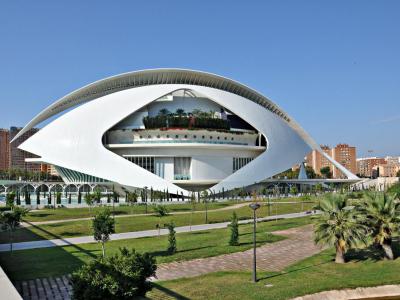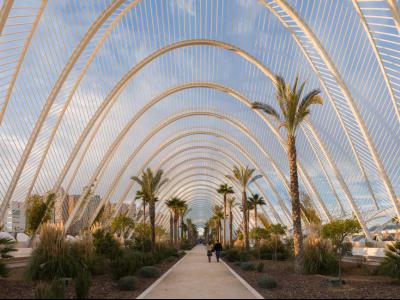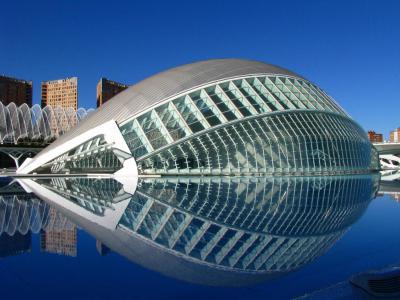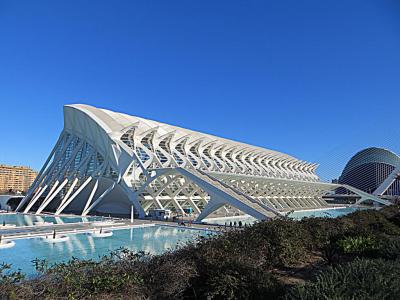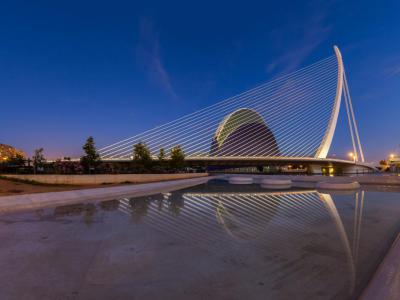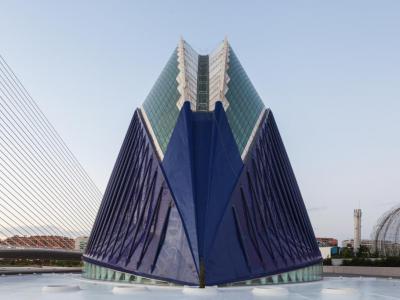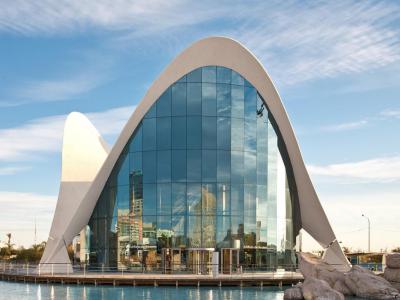Contemporary Architecture Walk (Self Guided), Valencia
With one foot in the past and the other one in the future, it is hard to find a European city more architecturally intriguing than Valencia. Among the multitude of styles, Valencia particularly excels at the cutting-edge contemporary architecture. She owes it to her own born and bred architect, Santiago Calatrava, renowned for his hyper-modern-surreal designs.
In the course of nearly two decades, from 1991 to 2009, Calatrava produced an ensemble of futuristic buildings and bridges that make up the famous City of Arts and Sciences complex. If only for one reason, it is thanks to these works that Valencia has put itself on the map as a city well worth visiting. Calatrava’s celebration of art and science in Valencia is indeed a must-visit place for architecture buffs, and includes:
Palau de les Arts Reina Sofia (Queen Sofía Palace of the Arts) – an opera house & performing arts center; home to Plácido Domingo's singers training program.
L'Umbracle – an outdoor art gallery with sculptures from contemporary artists and a landscaped garden featuring plant species indigenous to Valencia.
L'Hemisfèric – also known as the "eye of knowledge", the building, shaped as a giant eye, houses an IMAX Cinema, planetarium and laserium.
Prince Philip Science Museum – housed in an edifice resembling skeleton of a whale.
Assut de l'Or – the “Dam of the Gold”, a white single-pylon cable-stayed bridge crossing over the Túria Gardens.
L'Àgora (The Agora) – a multi-functional space resembling a pointed ellipse.
L'Oceanogràfic – an oceanarium, divided into ten areas, featuring different marine habitats.
If you ever wondered how something so contrasting as the sci-fi compound like this can coexist in the same urban setting with the sunny, paella-scented streets of Valencia, take this self-guided walk and find out!
In the course of nearly two decades, from 1991 to 2009, Calatrava produced an ensemble of futuristic buildings and bridges that make up the famous City of Arts and Sciences complex. If only for one reason, it is thanks to these works that Valencia has put itself on the map as a city well worth visiting. Calatrava’s celebration of art and science in Valencia is indeed a must-visit place for architecture buffs, and includes:
Palau de les Arts Reina Sofia (Queen Sofía Palace of the Arts) – an opera house & performing arts center; home to Plácido Domingo's singers training program.
L'Umbracle – an outdoor art gallery with sculptures from contemporary artists and a landscaped garden featuring plant species indigenous to Valencia.
L'Hemisfèric – also known as the "eye of knowledge", the building, shaped as a giant eye, houses an IMAX Cinema, planetarium and laserium.
Prince Philip Science Museum – housed in an edifice resembling skeleton of a whale.
Assut de l'Or – the “Dam of the Gold”, a white single-pylon cable-stayed bridge crossing over the Túria Gardens.
L'Àgora (The Agora) – a multi-functional space resembling a pointed ellipse.
L'Oceanogràfic – an oceanarium, divided into ten areas, featuring different marine habitats.
If you ever wondered how something so contrasting as the sci-fi compound like this can coexist in the same urban setting with the sunny, paella-scented streets of Valencia, take this self-guided walk and find out!
How it works: Download the app "GPSmyCity: Walks in 1K+ Cities" from Apple App Store or Google Play Store to your mobile phone or tablet. The app turns your mobile device into a personal tour guide and its built-in GPS navigation functions guide you from one tour stop to next. The app works offline, so no data plan is needed when traveling abroad.
Contemporary Architecture Walk Map
Guide Name: Contemporary Architecture Walk
Guide Location: Spain » Valencia (See other walking tours in Valencia)
Guide Type: Self-guided Walking Tour (Sightseeing)
# of Attractions: 7
Tour Duration: 1 Hour(s)
Travel Distance: 1.4 Km or 0.9 Miles
Author: nicole
Sight(s) Featured in This Guide:
Guide Location: Spain » Valencia (See other walking tours in Valencia)
Guide Type: Self-guided Walking Tour (Sightseeing)
# of Attractions: 7
Tour Duration: 1 Hour(s)
Travel Distance: 1.4 Km or 0.9 Miles
Author: nicole
Sight(s) Featured in This Guide:
- Palau de les Arts Reina Sofia (Queen Sofía Palace of the Arts)
- L'Umbracle Sculpture Garden
- L'Hemisfèric Building
- Prince Philip Science Museum
- Assut de l'Or Bridge
- L'Àgora (The Agora)
- L'Oceanogràfic
1) Palau de les Arts Reina Sofia (Queen Sofía Palace of the Arts)
The Queen Sofía Palace of the Arts (Palau de les Arts Reina Sofía) is an opera house and performing arts center in Valencia. Designed by architect Santiago Calatrava, it opened on October 8, 2005, and hosted its first opera performance, Beethoven's Fidelio, on October 25, 2006. Plácido Domingo, a renowned tenor and conductor, has a special connection to the palace and has established a program there for young singers.
The Queen Sofía Palace of the Arts is the crowning achievement of the City of Arts and Sciences project by renowned architect Santiago Calatrava. Started in 1995, this remarkable structure was completed through a collaboration between Dragados and Necso. It was officially inaugurated by Queen Sofía of Spain on October 8, 2005.
The Queen Sofía Palace of the Arts is the tallest opera house globally, soaring 14 stories high with three additional stories underground. It has a height of 75 meters (246 feet) and a curved-roof structure spanning 230 meters (755 feet). The building covers 40,000 square meters (431,000 square feet) and includes four auditoriums. The Main Hall seats 1,470 people and hosts opera performances, dance, and other arts. Above the Main Hall, the Auditorium accommodates 1,420 spectators with advanced sound and video systems. The Master Class (Aula Magistral) seats 400 and hosts chamber music concerts and conferences. The Martí i Soler Theatre, seating 400, is located beneath the Palau's base and serves as both a performance space and training center.
The Queen Sofía Palace of the Arts is the crowning achievement of the City of Arts and Sciences project by renowned architect Santiago Calatrava. Started in 1995, this remarkable structure was completed through a collaboration between Dragados and Necso. It was officially inaugurated by Queen Sofía of Spain on October 8, 2005.
The Queen Sofía Palace of the Arts is the tallest opera house globally, soaring 14 stories high with three additional stories underground. It has a height of 75 meters (246 feet) and a curved-roof structure spanning 230 meters (755 feet). The building covers 40,000 square meters (431,000 square feet) and includes four auditoriums. The Main Hall seats 1,470 people and hosts opera performances, dance, and other arts. Above the Main Hall, the Auditorium accommodates 1,420 spectators with advanced sound and video systems. The Master Class (Aula Magistral) seats 400 and hosts chamber music concerts and conferences. The Martí i Soler Theatre, seating 400, is located beneath the Palau's base and serves as both a performance space and training center.
2) L'Umbracle Sculpture Garden
The Umbracle is a mesmerizing sculpture garden and landscaped pathway adorned with native plant species found in Valencia. Among these botanical treasures are rockrose, lentiscus, romero, honeysuckle, bougainvillea, and palm trees. Nestled within its confines lies The Walk of the Sculptures, an open-air art gallery showcasing masterpieces by contemporary artists like Miquel from Navarre, Francesc Abbot, Yoko Ono, and others.
The Umbracle serves as a sanctuary for numerous sculptures, embraced by the beauty of nature. Designed by Santiago Calatrava, it serves as an entrance on the southwestern periphery of the City of Arts and Sciences, while also providing a roof over the adjacent car park. L'Umbracle was successfully completed in 2001.
Spanning an impressive length of 320 meters and width of 60 meters, this remarkable structure occupies the southern side of the complex. Its elegant form comprises 55 fixed arches and 54 floating arches, reaching a soaring height of 18 meters. These arches exhibit captivating parabolic shapes.
Delicately chosen for their seasonal transformations, the plants within the garden enchantingly change their hues throughout the year. The garden showcases a collection of 99 palm trees, 78 smaller palm trees, and 62 bitter orange trees. Moreover, it boasts an array of 42 shrub varieties originating from the Region of Valencia, including cistuses, mastics, buddleia, pampas grass, and plumbagos. Honeysuckle and cascading bougainvillea are among the 450 climbing plants that adorn the Umbracle.
Additionally, the garden houses 5,500 ground cover plants, such as lotus, Spanish Flags, and fig marigolds. Adding to its allure, more than a hundred aromatic plants, including rosemary and lavender, perfume the air with their delightful scents.
The Umbracle serves as a sanctuary for numerous sculptures, embraced by the beauty of nature. Designed by Santiago Calatrava, it serves as an entrance on the southwestern periphery of the City of Arts and Sciences, while also providing a roof over the adjacent car park. L'Umbracle was successfully completed in 2001.
Spanning an impressive length of 320 meters and width of 60 meters, this remarkable structure occupies the southern side of the complex. Its elegant form comprises 55 fixed arches and 54 floating arches, reaching a soaring height of 18 meters. These arches exhibit captivating parabolic shapes.
Delicately chosen for their seasonal transformations, the plants within the garden enchantingly change their hues throughout the year. The garden showcases a collection of 99 palm trees, 78 smaller palm trees, and 62 bitter orange trees. Moreover, it boasts an array of 42 shrub varieties originating from the Region of Valencia, including cistuses, mastics, buddleia, pampas grass, and plumbagos. Honeysuckle and cascading bougainvillea are among the 450 climbing plants that adorn the Umbracle.
Additionally, the garden houses 5,500 ground cover plants, such as lotus, Spanish Flags, and fig marigolds. Adding to its allure, more than a hundred aromatic plants, including rosemary and lavender, perfume the air with their delightful scents.
3) L'Hemisfèric Building
L'Hemisfèric, situated at the heart of the City of Arts and Sciences, is a multifunctional venue encompassing an IMAX Cinema, Planetarium, and Laserium. Its distinctive architectural design emulates that of a colossal eye, covering an expansive area of approximately 13,000 square meters.
This renowned structure, also referred to as the planetarium or the "eye of knowledge," designed by architect Santiago Calatrava, was completed in 1998. Its captivating composition resembles an eyelid, which gracefully unfurls to grant access to the surrounding water pool. The pool's bottom is crafted from glass, ingeniously creating the illusion of an integrated ocular entity. Within the concrete framework, the planetarium takes the form of a semi-spherical dome, measuring 110 meters in length and 55.5 meters in width. The shutter comprises elongated aluminum awnings that collectively ascend, forming a brise soleil roof. This unique roof smoothly opens along the curved axis of the eye, unveiling the dome, metaphorically known as the "iris," which houses the planetarium or Ominax theater. A set of stairs bisects the structure, leading down into the vaulted concrete lobby.
Translucent glass panels adorn the underground areas, allowing gentle illumination to permeate the pathways. The transparent roof, supported by concrete arches, interconnects with the sunken gallery. Notably, an extraordinary echo reverberates throughout the building, allowing individuals positioned at the opposing pillars within the eye to engage in conversation with each other.
This renowned structure, also referred to as the planetarium or the "eye of knowledge," designed by architect Santiago Calatrava, was completed in 1998. Its captivating composition resembles an eyelid, which gracefully unfurls to grant access to the surrounding water pool. The pool's bottom is crafted from glass, ingeniously creating the illusion of an integrated ocular entity. Within the concrete framework, the planetarium takes the form of a semi-spherical dome, measuring 110 meters in length and 55.5 meters in width. The shutter comprises elongated aluminum awnings that collectively ascend, forming a brise soleil roof. This unique roof smoothly opens along the curved axis of the eye, unveiling the dome, metaphorically known as the "iris," which houses the planetarium or Ominax theater. A set of stairs bisects the structure, leading down into the vaulted concrete lobby.
Translucent glass panels adorn the underground areas, allowing gentle illumination to permeate the pathways. The transparent roof, supported by concrete arches, interconnects with the sunken gallery. Notably, an extraordinary echo reverberates throughout the building, allowing individuals positioned at the opposing pillars within the eye to engage in conversation with each other.
4) Prince Philip Science Museum
The Prince Felipe Science Museum (Museu de les Ciències Príncipe Felipe) forms part of the futuristic City of Arts and Sciences, an architectural complex located in Valencia. Situated at the end of Luis García Berlanga Street, it is directed by Manuel Toharia, a renowned Spanish science writer and television personality.
Covering an impressive area of over 40,000 square meters (430,000 square feet) with a height of 55 meters (180 feet), the museum's design resembles the graceful form of a whale's skeleton. This distinctive façade was skillfully crafted by Santiago Calatrava and constructed through a collaboration between Fomento de Construcciones y Contratas and Necso. The construction of the museum commenced around 1994 and received its symbolic inauguration in March 2000 by Felipe VI. It officially opened its doors on November 13, 2000.
The museum's primary objective is to offer engaging interactive exhibitions and rotating collections that explore various aspects of science and technology. The museum boasts enduring displays showcasing electricity, genetics, zero gravity, and life in space. Additionally, it features a dynamic array of interactive temporary exhibitions that are regularly updated. Notably, scenes from the movie "Tomorrowland" (2015) were filmed at the City of Arts and Sciences, featuring captivating shots of the museum's cantilever.
Covering an impressive area of over 40,000 square meters (430,000 square feet) with a height of 55 meters (180 feet), the museum's design resembles the graceful form of a whale's skeleton. This distinctive façade was skillfully crafted by Santiago Calatrava and constructed through a collaboration between Fomento de Construcciones y Contratas and Necso. The construction of the museum commenced around 1994 and received its symbolic inauguration in March 2000 by Felipe VI. It officially opened its doors on November 13, 2000.
The museum's primary objective is to offer engaging interactive exhibitions and rotating collections that explore various aspects of science and technology. The museum boasts enduring displays showcasing electricity, genetics, zero gravity, and life in space. Additionally, it features a dynamic array of interactive temporary exhibitions that are regularly updated. Notably, scenes from the movie "Tomorrowland" (2015) were filmed at the City of Arts and Sciences, featuring captivating shots of the museum's cantilever.
5) Assut de l'Or Bridge
The Assut de l'Or Bridge, also known as El Jamonero or Pont de l'Arpa, is a striking cable-stayed bridge located in the City of Arts and Sciences in Valencia. Designed by Santiago Calatrava, a renowned Valencian architect and civil engineer, the bridge was completed in December 2008. Its name, l'Assut de l'Or, translates to the Dam of the Gold, paying homage to a nearby dam. However, Calatrava referred to it as the Serreria Bridge.
Situated in the southeastern part of Valencia, the bridge spans the Túria Gardens near the eastern edge of the City of Arts and Sciences complex. Its design draws inspiration from Calatrava's earlier work on a cantilever spar cable-stayed bridge in Seville, Spain, back in 1992. The Serreria Bridge features a curved pylon that leans backward and is supported by concrete counterweights embedded in the roadway.
One of the bridge's notable visual elements is the interplay between the curved pylon and the 29 parallel cables that support the bridge deck. At night, the cables and the pylon are illuminated by spotlights, enhancing the aesthetic appeal. The bridge deck accommodates two carriageways with three lanes each for vehicles, an additional lane for a tramway, and a dedicated path for pedestrians and cyclists along the central spine, created by the cable stays.
Situated in the southeastern part of Valencia, the bridge spans the Túria Gardens near the eastern edge of the City of Arts and Sciences complex. Its design draws inspiration from Calatrava's earlier work on a cantilever spar cable-stayed bridge in Seville, Spain, back in 1992. The Serreria Bridge features a curved pylon that leans backward and is supported by concrete counterweights embedded in the roadway.
One of the bridge's notable visual elements is the interplay between the curved pylon and the 29 parallel cables that support the bridge deck. At night, the cables and the pylon are illuminated by spotlights, enhancing the aesthetic appeal. The bridge deck accommodates two carriageways with three lanes each for vehicles, an additional lane for a tramway, and a dedicated path for pedestrians and cyclists along the central spine, created by the cable stays.
6) L'Àgora (The Agora)
The Agora (L'Àgora) is a versatile indoor area situated in the City of Arts and Sciences complex in Valencia, designed by the renowned architect Santiago Calatrava. Spanning 5,000 square meters, the building reaches a height of 70 meters and features an open floor plan resembling a pointed ellipse measuring approximately 88 meters in length and 66 meters in width. Depending on the configuration, it can accommodate up to 6,075 individuals.
This impressive structure serves as a transparent, spacious arena with a glass roof running along its central axis. To regulate the natural light from above, a movable framework is employed. The interior of the building showcases tall white steel arches, creating an organic atmosphere, while the exterior boasts a geometric and abstract design that remains striking whether seen during daylight or illuminated at night.
Officially inaugurated in November 2009, L'Àgora initially hosted the Valencia Open 500 ATP tournament, despite the ongoing construction at the time. The tournament continued for six years before concluding in 2015.
In early 2018, it was announced that Catalan architect Enric Ruiz-Geli had won a private architecture competition to construct the new CaixaForum Valencia within L'Àgora. The CaixaForum Valencia will encompass 6,500 square meters and house two exhibition halls, an auditorium with 300 seats, two multipurpose rooms, a bar-restaurant, a bookstore, and a second-level space dedicated to families and education. This multifaceted venue will accommodate art exhibitions, conferences, concerts, social events, educational and family workshops, as well as activities tailored for the elderly.
This impressive structure serves as a transparent, spacious arena with a glass roof running along its central axis. To regulate the natural light from above, a movable framework is employed. The interior of the building showcases tall white steel arches, creating an organic atmosphere, while the exterior boasts a geometric and abstract design that remains striking whether seen during daylight or illuminated at night.
Officially inaugurated in November 2009, L'Àgora initially hosted the Valencia Open 500 ATP tournament, despite the ongoing construction at the time. The tournament continued for six years before concluding in 2015.
In early 2018, it was announced that Catalan architect Enric Ruiz-Geli had won a private architecture competition to construct the new CaixaForum Valencia within L'Àgora. The CaixaForum Valencia will encompass 6,500 square meters and house two exhibition halls, an auditorium with 300 seats, two multipurpose rooms, a bar-restaurant, a bookstore, and a second-level space dedicated to families and education. This multifaceted venue will accommodate art exhibitions, conferences, concerts, social events, educational and family workshops, as well as activities tailored for the elderly.
7) L'Oceanogràfic (must see)
Situated on the dry Turia River bed southeast of Valencia's city center, L'Oceanogràfic is a captivating oceanarium that showcases diverse marine habitats. This architectural marvel was collaboratively designed by Félix Candela, an esteemed architect, and structural engineers Alberto Domingo and Carlos Lázaro. It is an integral part of the renowned cultural complex known as the City of Arts and Sciences, and it officially opened its doors on 14 February 2003.
Spanning an impressive 110,000 square meters (1,200,000 square feet), the Oceanographic stands as the largest complex of its kind in Europe. Its massive water capacity, reaching 42,000,000 liters (11,000,000 US gallons), includes a dolphinarium with a volume of 26,000,000 liters (6,900,000 US gallons) and an ocean tank housing sharks, rays, and other fish with a capacity of 7,000,000 liters (1,800,000 US gallons).
Within this vast space, 45,000 animals from 500 different species find their home, encompassing sharks, penguins, dolphins, sea lions, walruses, beluga whales, birds, reptiles, and invertebrates. These creatures inhabit nine two-tiered underwater towers, each representing a significant ecosystem on Earth. Remarkably, the aquariums utilize seawater pumped from La Malva-Rosa beach.
The park is divided into ten distinct areas, offering visitors a diverse range of experiences. These areas include Mediterranean habitats, the Arctic oceans, islands, the tropics, the temperate seas, the Red Sea, a dolphinarium, an area dedicated to mangrove swamps and marshland, and a splendid garden boasting over 80 different plant species.
The Oceanographic's unique architectural structure features a steel-fiber reinforced concrete thin-shell design. Candela drew inspiration from the iconic hyperbolic parabola (hypars) shape of his earlier creation, the Los Manantiales Restaurant in Mexico City, which he designed back in 1958.
At present, the Oceanographic operates in partnership with the Vancouver Aquarium Marine Science Centre in Vancouver, British Columbia, Canada, further enhancing its global connection and commitment to marine science and conservation.
Spanning an impressive 110,000 square meters (1,200,000 square feet), the Oceanographic stands as the largest complex of its kind in Europe. Its massive water capacity, reaching 42,000,000 liters (11,000,000 US gallons), includes a dolphinarium with a volume of 26,000,000 liters (6,900,000 US gallons) and an ocean tank housing sharks, rays, and other fish with a capacity of 7,000,000 liters (1,800,000 US gallons).
Within this vast space, 45,000 animals from 500 different species find their home, encompassing sharks, penguins, dolphins, sea lions, walruses, beluga whales, birds, reptiles, and invertebrates. These creatures inhabit nine two-tiered underwater towers, each representing a significant ecosystem on Earth. Remarkably, the aquariums utilize seawater pumped from La Malva-Rosa beach.
The park is divided into ten distinct areas, offering visitors a diverse range of experiences. These areas include Mediterranean habitats, the Arctic oceans, islands, the tropics, the temperate seas, the Red Sea, a dolphinarium, an area dedicated to mangrove swamps and marshland, and a splendid garden boasting over 80 different plant species.
The Oceanographic's unique architectural structure features a steel-fiber reinforced concrete thin-shell design. Candela drew inspiration from the iconic hyperbolic parabola (hypars) shape of his earlier creation, the Los Manantiales Restaurant in Mexico City, which he designed back in 1958.
At present, the Oceanographic operates in partnership with the Vancouver Aquarium Marine Science Centre in Vancouver, British Columbia, Canada, further enhancing its global connection and commitment to marine science and conservation.
Walking Tours in Valencia, Spain
Create Your Own Walk in Valencia
Creating your own self-guided walk in Valencia is easy and fun. Choose the city attractions that you want to see and a walk route map will be created just for you. You can even set your hotel as the start point of the walk.
Old Town Walking Tour
Valencia’s Old Town stands apart from many in Europe for how effortlessly its many layers of history coexist. Beneath modern squares, ancient Roman streets and forum remains lie quietly preserved. The maze-like layout-shaped during the city’s Islamic period-was never swept away after the Christian Reconquest. Instead, it survived and evolved, now lined with Gothic churches and Baroque façades... view more
Tour Duration: 2 Hour(s)
Travel Distance: 3.0 Km or 1.9 Miles
Tour Duration: 2 Hour(s)
Travel Distance: 3.0 Km or 1.9 Miles
Valencia Introduction Walking Tour
Valencia, Spain’s third-largest city, carries a rich history that stretches back to 138 BC, when it was founded as a Roman colony for battle-tested veterans. Known then as “Valentia”, meaning “valor,” it honored the courage of its first inhabitants. The city was destroyed in 75 BC by Pompey the Great but was rebuilt within a century, eventually becoming home to Visigoths and later the... view more
Tour Duration: 2 Hour(s)
Travel Distance: 3.2 Km or 2 Miles
Tour Duration: 2 Hour(s)
Travel Distance: 3.2 Km or 2 Miles
Valencia's Classical Architecture Tour
In Valencia, the architecture tells you right away-this city has layers. It's not just a coastal getaway with sunshine and beaches. Beneath the bright skies, “Spain’s Third Capital” reveals a blend of styles both rich and unexpected-at once bold in contrast and delicate in detail. Nowhere is this more evident than in the Old Town, where nearly every corner seems to offer a visual... view more
Tour Duration: 2 Hour(s)
Travel Distance: 3.3 Km or 2.1 Miles
Tour Duration: 2 Hour(s)
Travel Distance: 3.3 Km or 2.1 Miles
The Most Popular Cities
/ view all



